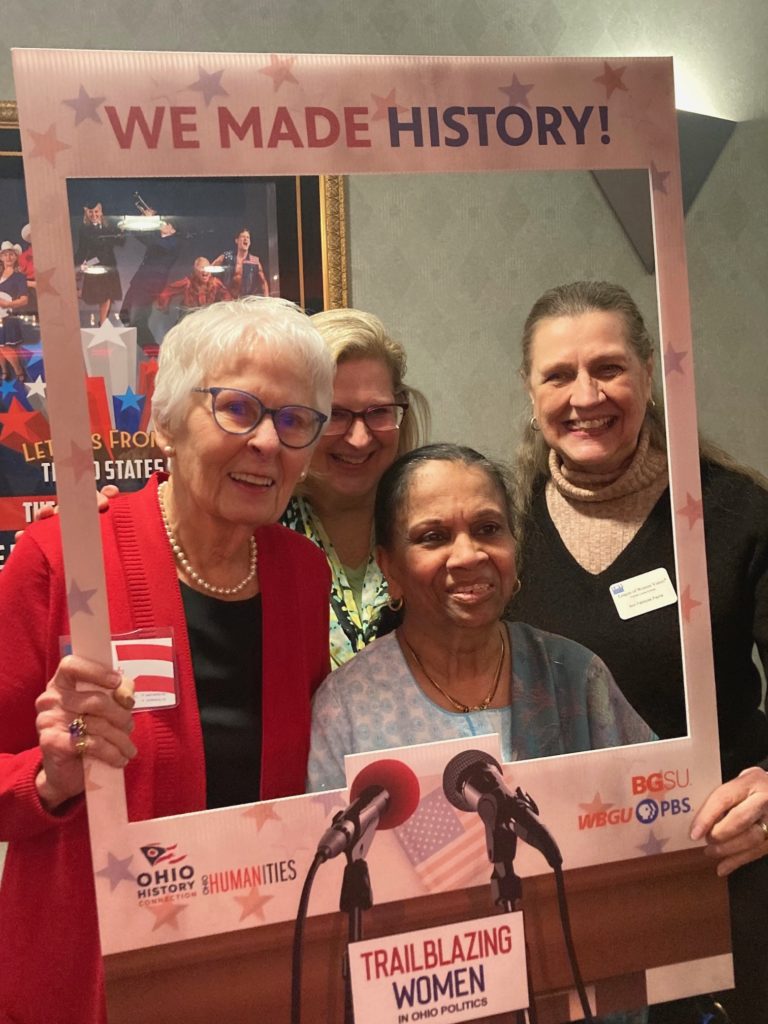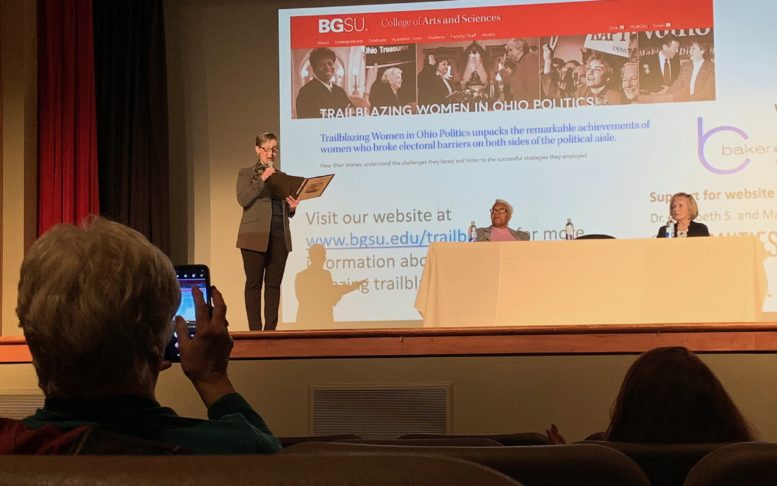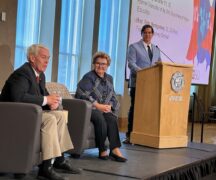By JULIE CARLE
BG Independent News
Ohio’s rich history of trailblazing women in politics made it to the big screen Thursday night when the WBGU-PBS documentary “Trailblazing Women in Ohio Politics” premiered.
The documentary, which was the brainchild of Melissa Miller, professor of political science at Bowling Green State University, was shown publicly for the first time at the Maumee Indoor Theater. The event, hosted by Bowling Green, Perrysburg and Toledo-Lucas County local Leagues of Women Voters, showcased the challenges and achievements of some of the women who were “firsts” in Ohio’s political arena.
Miller has studied, taught and conducted research about women in politics for many years and was very familiar with the scholarly research about women’s experiences running for office in the mid- to late-20th century.
“What was so amazing for me was to hear trailblazers like Helen Rankin and Betty Montgomery bring the research to life. Things I had known for some time – like the fact that political gatekeepers traditionally underestimated women – were now being expressed on camera by women who had endured this kind of reception. Yet they were undaunted and paved the way for the larger group of women who now hold elective office today,” Miller said.
The eight featured women came from both sides of the political aisle. They shared many similar experiences of working in men-dominated environments, but they also had many unique and different experiences.
Wood County’s own Betty D. Montgomery knew she didn’t want to become a teacher, secretary or housewife. Her path into politics was through law. Montgomery’s accomplishments included first woman county prosecutor, not only in Wood County but in all of Ohio’s 88 counties; Ohio attorney general; and Ohio auditor.
Toledo’s Marcy Kaptur, who is the longest-serving woman in the U.S. House of Representatives, came from humble beginnings and unconventional fundraising. She was a high school student at St. Ursula’s when the sisters took a group of students to Washington D.C. She was awestruck, but never dreamed she would be elected to the U.S. Congress.
Many people doubted her because she didn’t come from wealth, as so many representatives did. She raised funds through Polish dinners and selling coffee cakes. Critics compared her fund-raising tactics to those of someone running for school board. Through her dinners, bake sales and constant effort to register new voters, she gained support from unions, churches and the Latino/a population. “I still meet people that I registered 40 years ago,” she said.
Helen Rankin of Hamilton County didn’t aspire to politics. When her husband Ohio Rep. James W. Rankin passed away in office in 1978, she was appointed to fill his term. She became the first African American woman in the Ohio legislature.
“People thought I knew nothing about the job, but my husband and I communicated very well and talked about it a lot. I proved that I did know enough,” Rankin said. She was in office as the only Black woman for eight years before another Black woman was elected to the Ohio House.
Rhine McLin of Dayton also was not interested in politics but was appointed to the Ohio House in 1988 to fill her father’s position after his death. “I became a people’s representative just like my dad,” she said.

The film project became a labor of love for Miller and the team of experts at WBGU-PBS “who really know how to bring a project like this to life,” Miller said. “We were committed to telling the stories of women from both sides of the political aisle who have broken electoral barriers in Ohio politics. Once we started interviewing the trailblazers, we knew we had quite a story to tell.”
She praised Producer Kaitlyn Kuch Finkler for her strength at storytelling through documentary filmmaking.
“We had literally hours of trailblazer interview footage that is now woven together in a compelling and visually interesting fashion that really carries the viewer along. Kaitlyn knew exactly where to put the laugh lines,” Miller said.
First woman Lieutenant Governor Nancy Hollister was one of the trailblazers who provided a few moments of comic relief, including her first activism for women’s rights.
As a student at Kent State University, she was upset that the women had certain hours they had to be in the dorms while the men had no restrictions. She staged her first protest and thought she had support from other women to stand outside with her when the doors locked for the night. When that time came, she was the only one outside, she recalled with a laugh. Whether or not anyone was aware of her protest, the restricted hours for women were abolished soon after.
“What surprised me most was the number of times we laughed during the filming,” Finkler said. “Politicians are held to such high standards in and out of the spotlight that we sometimes forget that they are also people with lives, families and personal obstacles that they are dealing with in conjunction to their careers.”
Other women trailblazers who were interviewed included Jo Ann Davidson, first woman on Reynoldsburg City Council and the first woman speaker of the Ohio House of Representatives; and Mary Ellen Withrow, first woman on Elgin School Board, who rose to be Ohio Treasurer and U.S. Treasurer.
Davidson, who has established a leadership institute for young women, got her start by attending political events with her father, “and it stuck with me,” she said. For many years she was doing a lot of political work for the Franklin County Republican Party and decided to try to get herself elected. It worked, even though there weren’t as many opportunities for women at the time. Today she tells young women, ”Never say ‘I’m not capable.’”
Withrow fought against the mindset that she couldn’t do the job because she had four children. She worked hard and was often exhausted, but she got used to being in a room of all men.
A post-film panel discussion featured Donna Owens, Toledo’s first woman mayor, and Paula Hicks-Hudson, Toledo’s first African American woman mayor. They shared some of their experiences in a panel session after the screening.
“It’s important to remember that the halls of power now open to women were once closed. There is still progress to be made,” Miller said. Currently, women are 50 percent of the population but only 28 percent of the U.S. Congress and 33 percent of state legislators across the country.
“This film can inspire women – and men, for that matter – to consider running for office and serving the public in this important way,” she said.
“While this story’s touchstone is politics, it covers such a vast number of issues women have dealt with throughout history and some of which women still face today. Our hope is that young women will see this and be inspired to take on projects and roles that may seem impossible to them, and blaze a path for future generations, as the women featured in our documentary have done,” Finkler said.
“I received a text from a friend who went to the Maumee screening who said she laughed, nodded her head, clapped and had a few tears,” Miller said. “That’s a testament to the power of these trailblazer stories and the talent of the WBGU-PBS team.”
The documentary will be shown again locally on BGSU’s campus. The screening, at 7 p.m. on March 21 in the Bowen-Thompson Student Union Theater, is free and open to the public. The Bowling Green League of Women Voters is the sponsor.
WBGU-PBS will premiere the film on air March 23 at 9:30 p.m. with additional broadcasts scheduled for March 24 at 3:30 p.m. and March 25 at 7:30 p.m. The film will also be available free starting March 23 on wbgu.org.
There is also a website at bgsu.edu/trailblazers dedicated to the women trailblazers featured in the film plus bonus interviews with additional trailblazers. Miller is working with Michelle Sweetser of BGSU’s Center for Archival Collections where the interviews will be housed. “The fact that these important stories will be preserved for generations to come is very meaningful to me as an educator,” Miller said.





